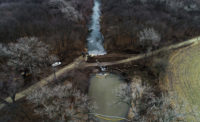Officials in beachfront towns from Cape May on the Jersey Shore to Montauk on Long Island have been celebrating the return of their beaches and boardwalks in time for the start of summer this month. But there is still much work left to do to repair Superstorm Sandy's damage along the coastline and to harden defenses for future storms. There is even more debate on what are the best long-term protections and who will pay for them.
Pushing Sand
As part of its traditional mission, the U.S. Army Corps of Engineers (USACE) is ramping up beach replenishment projects at Sandy-ravaged beaches, but this year it has new authority to restore them to their original design profile, says the USACE, New York District, which is managing work in New York and more than half of New Jersey.
In New York, the Corps expects to place an estimated combined total of 7.7 million cu yd of sand in Queens at Rockaway Beach, in Brooklyn at Coney Island and in three Long Island areas: Gilgo Beach, beaches west of Shinnecock Inlet and Westhampton. The agency will also repair a levee and tide gate at the previously constructed coastal storm risk-reduction project at Staten Island's Oakwood Beach, while FEMA has allocated $5.9 million to raise sand levels and restore dunes there and at three other nearby hard-hit beaches.
In New Jersey, the New York district will place about 16 million cu yd of sand north of Manasquan outlet, with additional work south of that to be managed by the Philadelphia district. The agency now is advertising these contracts and plans to begin making awards this month and next, with work to be completed by next June, says a Corps spokesman.
Weeks Marine, Cranford, N.J., will be ramping up its beach replenishment work this month on Absecon Island, near Atlantic City, N.J. The contractor will use equipment now doing maintenance dredging off the North Carolina coast to place an estimated 1.6 million cu yd of sand, says President Richard S. Weeks. "The Corps wants it done sooner than later," he says, adding that equipment also may be brought up from the Gulf Coast for work anticipated in New Jersey, Delaware and Long Island. Last month, Weeks managed the removal of the JetStar roller coaster from its precarious spot in the surf off Seaside Heights, N.J., which had become an icon of Sandy's destruction (p. 72). The attraction is set to be rebuilt next year.
The Corps announced on May 28 the launch of a two-year comprehensive $20-million study, authorized in post-Sandy legislation, to determine North Atlantic coast flood risks and resiliency strategies.
Meanwhle, debate continues on costs and benefits of dune building, beach replenishment and barrier-island reconstruction. In a televised town-hall meeting last month featuring a variety of officials, Matt Doherty, mayor of Belmar, N.J., questioned whether Sandy's damage to the town's beachfront might have been mitigated if replenishment work, which was not done due to lack of funding, had been done. Another town-hall speaker, John Boulé, a former Corps district commander and now a Parsons Brinckerhoff vice president, said that "engineered beaches" are for protection. "Recreational benefits are ancillary."
In the NYS 2100 Commission report issued earlier this year (p. 47), a New York state commission recommended more dredging and dune construction to fix vulnerabilities and "preemptively prevent breaching by future storms." But in a March 15 letter, Robert Young, director of the Program for the Study of Developed Shorelines at Western Carolina University, took issue with closing breaches on Long Island's Fire Island. "Closing inlets in natural areas, parks and wilderness areas should require a very, very high burden of proof that the inlet is causing harm," he said. "Closing storm-formed inlets may seem like the logical response for those managing barrier-island shorelines, but doing so ignores the significant benefits these inlets provide and will likely increase the vulnerability of the island and mainland over the long term."
New Jersey lawmakers in April passed bills that gave priority to breach replenishment projects that emphasize dune building and wetlands restoration. But politicians and shore homeowners are watching a case now in the state courts that could determine the extent and cost of dune construction along the state's coast. The case involves compensation sought by homeowners in the shore town of Harvey Cedars to allow an easement for construction of a 22-ft-high dune they claim will impact their property value. Some observers say that if homeowners must be compensated for diminished values due to blocked ocean views, shore protection projects could become impractical. Gov. Chris Christie (R), who supports dune construction, has taken a hard line against the homeowners, says NJ Spotlight, an online publication that covers state issues.
There also is debate along party lines over a proposal by state Democrats to create a coastal commission to prevent overdevelopment. Republican lawmakers oppose the measure as an added layer of bureaucracy in the recovery effort.
Industry calls for a more regionalized management of restoration strategies. But opposing views on climate change impacts are held by New York Gov. Andrew Cuomo (D), who sees a greater risk ahead, and by Christie, who told a gathering at the Jersey Shore town of Lavallette last month that he did not think "there's been any proof thus far that Sandy was caused by climate change." However, industry experts are determined. "There has to be a strategy to properly reduce risk in the whole region," Boulé says. "None of what the Corps has done in New York and New Jersey is designed to stop a hurricane. That's why we need an integrated strategy."
Meanwhile, many are awaiting the release of New York Mayor Michael Bloomberg's Special Initiative for Rebuilding and Resiliency that will outline new climate change-focused measures. The report could be out by mid-June, according to industry sources. City officials and industry experts close to the project are tight-lipped on what the estimated $300 million in resiliency priority investments will advocate. But one online climate-change blogger claims the initiative "is unlikely to recommend the construction of tidal barriers or a directed retreat from vulnerable coastlines."









Post a comment to this article
Report Abusive Comment